With snakes the general rule is that you should leave them alone and they won’t come chasing after you – but should you irritate one then watch out!
Many snake bites occur when people take a stick and poke at snakes, pretend they know what type it is – sometimes this is hard because many venomous and non-venomous species look quite similar – and show off in trying to catch or ‘handle’ the snake.
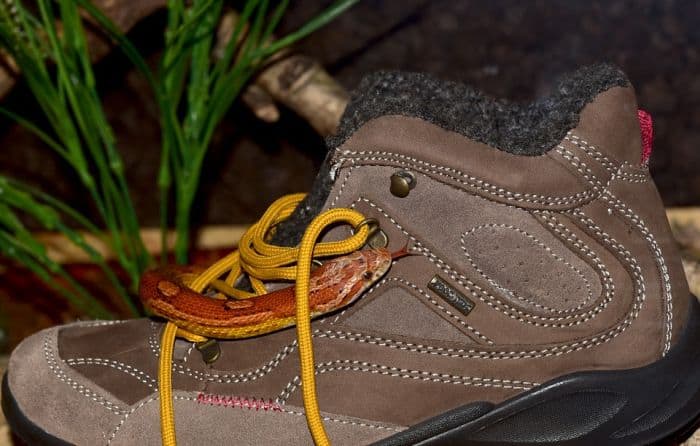
Then there are those who decide to use their vehicles to run over a snake. The problem with this is that the snake may be injured and get into the undercarriage or engine of the car. So, later when you are driving, it may pop up in the engine, or come out from under the dashboard.
Snakes like warmth and may find the engine an attractive place to warm up anyway – like the experience of these people, who when driving along felt things weren’t quite right under the hood and found a huge python:
When you are hiking in summer, you’re likely to come across snakes on the trail warming up in a patch of sunshine, so you need to be alert.
Now for the good news – only 0.06% of snakebites in the US result in human death – that’s odds of one in 50 million. Poison Control Centers in the US average around 8,000 snakebite reports annually.
The not so good news is that pets get bitten more than people – around 150,000 snakebites are reported annually, and deaths range from 1% to 30%.
Table of Contents
Non-Venomous Snakes in the United States
Only three of the states in the USA have no venomous snakes:
- Alaska – it’s far too cold for them, although very, very occasionally a snake may be sighted near the southern border, but not a venomous one, probably heading south to warmer weather and wondering how it ended up where it did.
- Hawaii – no snakes on land, and if you live here you’re not allowed to keep them as pets either so there is no chance of any escaping into the wild, like the Burmese pythons that escaped into the Florida Everglades. Hawaii does have the venomous yellow-bellied sea snake – but they are out in the deeper ocean, not on the land. Should one be washed up they cannot crawl, so you won’t be chased across the sand by one – just leave it alone.
- Maine used to have timber rattlesnakes but due to human expansion and loss of forest habitats there seem to be none in this state. One may slither in though – who knows. Timber rattlesnakes are however the least likely to bite of all the rattlesnakes – giving plenty of warning rattles to let you know they are around.
Check out our list of over a dozen common non-venomous snakes you may encounter.
Top 4 Most Venomous Snakes in the U.S.
The rest of the states do have venomous snakes, plenty of types, but these are the main four to worry about in terms of toxicity of venom…
Copperheads
These are responsible for the most bites compared to the other venomous species of snakes in the US.
This is because, rather than darting off into the undergrowth, they freeze instead, so if humans are not looking where they are going they will get too close or step on one resulting in a bite.
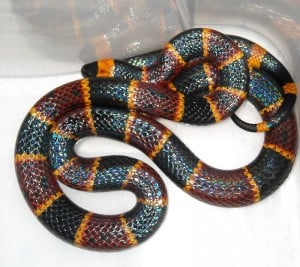
Coral Snakes
This is one of the deadliest as its venom can kill within two hours if medical attention is not received. The snakes are pretty shy, and you’re unlikely to come across one. Keep a lookout, though, if you are hiking or camping in the Southeast U.S.
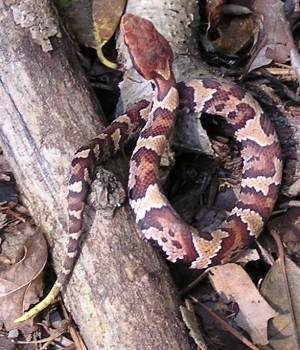
Cottonmouth or Water Moccasin
This snake stays hidden in the water so it accounts for a number of bites as people can’t see them underwater. The venom is cytotoxic, meaning it will eat away at the flesh around the bite site. Fatalities are low, as modern antivenom is effective, but you need to get help fast.
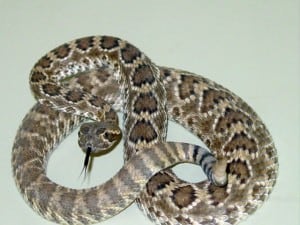
Rattlesnakes
The Eastern Diamondback is the deadliest, has the largest fangs of any of the rattlesnakes, and has very potent venom, which it can administer in large doses when it bites. Rattlesnakes generally account for the majority of serious, possibly lethal bites.
What Other Common Snakes Can Hurt You?
Besides the four most venomous types of snake we just talked about, there are over 20 venomous species in the US. There are 17 types of rattlesnakes, and all are poisonous to some degree. Learn your snakes by buying a field guide appropriate to your area, or getting a wall chart so your kids can identify them accurately.
You can see a full list of venomous snakes in North America here.
Although they’re not native to the United States, Burmese pythons that have escaped from their owner’s homes (or have been illegally released when they become too much trouble or too big to care for), have taken over in the Florida Everglades:
There are tens of thousands of them there with no natural predators, so unless there is some kind of intervention the numbers will keep increasing. Pythons can kill domestic, pets but are unlikely to attack humans unless provoked.
Many people choose to keep snakes as pets, but often these escape, or are even released when they become too much trouble. Often, the only alert that there is a python free in the neighborhood is when pets go missing!
Snakes in Other Parts of the World
India has a huge number of deaths to snakebites, around 50, 000 per year, firstly because there are so many venomous snakes in that country, and secondly, many are bitten when sleeping or getting into bed as they sleep on the floor (and snakes come in for the warmth).
Watch this video of a woman in Asia who was woken when a python bit her twitching foot:
The UK’s only venomous snake is the adder or viper. There are three other non-venomous species in the UK – so if you are an ophidiophobe (or in simple language a snake-o-phobe), then this might be the place to settle, or perhaps New Zealand which has no venomous snakes at all.
The young girl in this video was woken by a carpet snake – an Australian snake which is non-venomous, and actually welcomed by many homesteaders, as once one moves into a shed, rodent populations are kept under control:
Farmers say it keeps other venomous snakes away. However, this teen didn’t want one that close in her bedroom!
There are plenty of scary videos and posts about Australia’s deadly snakes. Yes, Australia has many of the deadliest in the world, but this video gives a balanced view of the venomous snakes:
In Australia there are:
- the Eastern brown
- the Inland taipan
- the Coastal taipan
- mainland tiger snake
- the red bellied black snake
- lowlands copperhead
- and the western brown
… to name some of the deadliest of the 170 species of snakes in Australia.
In Southern Africa, the black mamba is one of the most feared snakes as they can move faster than a human can run, can throw themselves far forward to strike, are quite aggressive, can grow as thick as a man’s forearm, and have a deadly venom.
This video shows a fight to the death between a black mamba and a mongoose. What is fascinating is that the mongoose has acetylcholine receptors adapted to make it immune to venomous bites:
The advice that follows to deal with snake encounters is divided into three sections:
- Camping
- Hiking
- Around the house / homestead
Avoiding Snake Encounters When Camping
When you’re camping, the heat from fridges running or the warmth of your bedding can attract snakes, and they will slide in, which is why your tent needs to be securely zipped at all times (except when you are walking in and out of it). Backpacks and clothing bags also need to be kept zipped up.
Once, when we were getting ready to leave for a camping trip, my husband put his bag of clothes down on the floor of the garage. It wasn’t zipped up, and as he turned back from putting something else in the vehicle, he saw a snake slide into his bag.
He called me, “I just saw a snake go in my bag – don’t put it in the car.” So carefully I lifted out each garment until we found the snake, then it was time for our homemade snake catcher to come into operation.
It is made from an old fishing rod – the eyes are still there, and a piece of fishing line is fastened to the lowest eye, then threaded up through the eyes to the top.
The loop is big enough to go over the snake’s head. Then, when it’s in the loop, you simply pull to tighten so it is secure. Most times you don’t want to kill the snake, but simply release it elsewhere.
If it’s super poisonous, you simply pull the loop tight and garotte it. In the case of this one, we simply released it into the bush across the road from us. It was a frog eating snake, and only very mildly poisonous.
It’s best to research the area you plan on hiking or camping to find out what snakes you may encounter, their habits and the kind of action you should take should you encounter one.
The website for the National Park or state campsite you may be visiting will give information, as will the rangers once you arrive.
For example, if you plan on camping close to waterways, you may be advised to choose ground away from the area where water moccasins may be lurking. The rangers will also be able to tell you which areas of the trail you’re most likely to encounter snakes.
Avoiding Snake Encounters While Hiking
Summertime hikes are the ones most likely to result in snake encounters, as they lie on paths and trails to warm up during the day, and in very hot areas may move and hunt at night when rodents come out.
A flashlight at night is a must when camping – not only to see where you are going, but to check for snakes in the pathway, many hunt at night, waiting for insects to cluster around pathway lights, or frogs to come out after insects.
Hiking boots are not only good for supporting your feet and ankles, but can also save you from a snake bite. Combine with thick socks that come well above the ankles.
Most times, people are bitten on the ankle and, should a snake have a go at you, at least the socks and boots will provide some protection. The majority of bites occur on the limbs – legs, and hands.
In areas with long grass where there is a high likelihood of snakes, people are advised to wear long pants. Hikers traditionally wear shorts as they leaves the legs free for climbing, however sports pants are now made with material with plenty of stretch to it so long pants will not be a hindrance. At least they may save you from the worst of the bite.
It is tempting to walk along listening to the birdsong, eyes up in the trees, or looking at the scenery instead of keeping a lookout on the ground.
Most snakes will get out of your way once they sense footsteps approaching but a snake may be caught unawares if you stumble on it suddenly and may rear up to strike in self-defense.
Snakes react to vibrations on the ground, so if you’re one of those who walk very lightly, a snake might not feel the vibration, and refer to hike alone a snake may not be aware. They are more likely to be aware of larger groups.
For this reason, many hikers carry a stick, which not only supports you on uneven terrain, but can also be used to make a bit more vibration as you walk, so that snakes know something is coming their way and can skedaddle off the path.
If you do encounter a snake and it does not move off in a hurry – most are incredibly fast at making a getaway, then it could mean it is injured, in which case it could be dangerous, or is simply one of those slow-moving types.
Remember snakes can rear up quite high and fling themselves forward to bite, so make sure you keep a safe distance of 4 foot or so. The general rule is twice the snake’s body length between yourself and it – so if it’s a large one increase the distance you maintain.
Even if a snake looks dead don’t be tempted to ‘examine’ it too closely. Even though it may be officially ‘dead’ there still may be a reflex action and it can bite, and the venom will still be effective. Some snakes, like the hognose snake may even play dead.
Don’t poke at snakes with a stick. Rather stay a safe distance until it slithers off the path, or if it continues lying there you’ll have to make your way around it, giving it plenty of room.
Never take it upon yourself to kill a snake you think is venomous. Firstly, there are many lookalikes – like the false coral snake and the real one, and you may be killing something perfectly innocent.
Secondly, most bites occur when people are trying to kill and snake that it’s defending itself, and thirdly when out camping or hiking you are in their territory – they have their part to play in maintaining the balance in the ecosystem.
Always shake out your boots before putting them on. Don’t stick your fingers inside – just shake them and maybe shine a light inside.
Fortunately, I haven’t had the experience of a snake in a hiking boot but I have had a frog inside one. You start sliding your foot in and something soft moves inside…. Horrors, until you identify it as a frog.
Don’t stick your hands into woodpiles without checking them out first. Similarly, don’t reach into cracks between rocks unless you have put a stick in the crack first and nothing has fastened its fangs to the stick!
When hiking with a dog it’s tempting to let the dog run free – that’s fine in winter when the snakes should be hibernating but in summer rather keep the dog on a shortish leash so if you see a snake, or more likely the dog sees it first, you can control the dog.
Most dogs are pretty smart if they have grown up on a homestead or farm where they encounter snakes, but an apartment puppy may be too curious for its own good.
Should your dog encounter and take on a snake, don’t shout at the dog as it will divert it’s attention, and that is when the dog is likely to get bitten. Dogs usually have good natural instincts.
Don’t miss out on amazing hikes just because you’re in rattlesnake country. If you get bitten, you‘ll be taken care of if you can get help quickly. Your chances of dying from snakebite in are negligible, but your chance of getting bitten is one in 37,500 in the U.S.
It’s tempting to hike alone, to clear your head, meditate, or commune with nature. However, always let someone know where you are, what time to expect you back, and have some form of communication on you, so if you are bitten rescuers can locate your position using your cell phone or a satellite phone, and get you the help you need.
Snakes Around the Home
Do everything you can to keep your home free of snakes by providing them with no source of food, no hiding places, or warm spots they can access when it’s cold, and no quiet damp places to cool off in summer.
Try to limit entry by making sure your doors seal very well, and are kept shut. Snakes manage to fit through even the smallest of spaces, like between the fixed pane and the sliding pane on patio doors, under doors, and through gaps in window sills.
In South Africa I once had a 5-foot Mozambique spitting cobra enter my house through that gap between the sliding door panels. I had to get a snake removal guy to come and take it away. And what alerted us to its presence under the couch where we sat to watch TV? The cat.
Cats certainly have their uses. Most cat owners have probably had their fur buddies come in with a dead snake clenched firmly between those sharp teeth. Cats are smart – they don’t usually play with a snake like a mouse – they kill it fast!
Garages and store rooms are favorite hiding places for snakes because they can lurk there undisturbed until someone decides to get sports equipment, or take out little used tools – then comes in for a nasty surprise.
They particularly like heat sources, so if you have a refrigerator or dryer in the garage watch out for what may be lurking in the back near the motor. Many people found snakes in their car engine compartments – the reptile having decided that a warm car engine makes a perfect sot to curl up overnight.
Keep your outside areas, roof and storage rooms as rodent free as possible. Some cats are good mousers, but fox terriers can be even better at dealing with rodents.
If you don’t have a terrier of your own you can always ask a friend who owns one of these dogs to bring it along for a morning.
Brisbane City Council in Australia currently has rodent control dogs that live a great family life at home, get to come to work with their masters, and go out on calls to identify where rat and mice nests are in people’s homes and businesses.
In medieval times a rat-catcher would come along to the castle with his pack of fox terriers and clear the castle of rats for a fee. Castles, with their stores of grain in case of siege, were perfect hideouts for rats.
These days, it’s chicken feed and animal feed stored on homesteads that attract the rodents, and following the rodents are the snakes.
If you’re aware of non-venomous snakes that are helping keep the rodents under control then don’t dissuade them, but if you have venomous snakes then the safety of children, livestock, and pets needs to be protected.
If one snake moves in with its mate you’ll soon have a problem like this homeowner who reported seeing a few snakes around, but when the snake removers came in there were dozens of them. Watch how many here:
Check basement windows are secure – snakes can get through really small gaps. Snakes often choose basements that are seldom used as a place to hibernate, or get themselves into the crawl spaces under older houses. If you see shed skin around, then know that the snake has been there quite a while.
To avoid kids waking up with snakes in their bedrooms, make sure tree branches are not hanging near their windows especially if they are on the second floor, and that pretty looking ivy or vines are growing against the house giving snakes easy access.
If bedrooms are on the ground floor, keep fly screens shut so snakes can’t enter through open doors or windows.
Snakes Around the Homestead
All feed bins should seal really well, and you should be careful when transferring feed that any that spills on the floor is removed at once, to discourage rodents, a snake’s main prey.
Disclosure: This post has links to 3rd party websites, so I may get a commission if you buy through those links. Survival Sullivan is a participant in the Amazon Services LLC Associates Program. As an Amazon Associate, I earn from qualifying purchases. See my full disclosure for more.
Snakes like to get up into open rafters, and if you are tempted to store timber in the open rafters just be aware that this will make a great hiding place for snakes. To discourage them you can use snake repellent granules, or glue traps.
Glue traps may work on smaller snakes, but the bigger ones may manage to work themselves free. Use glue traps inside as moisture outside will affect their efficiency. The granules and traps can be used under the house too.
For chicken coops, some people put broken glass in a foundation trench, then cast the cement foundation of the coop above it, so should rats try to dig their way in for the chicken feed and the snake follows they will come up against the broken glass. This is for coops that have an earth floor, not those with a solid cement flooring.
The floor of the coop itself is also covered in broken glass, then about 6 inches of ground is packed on top. Doors to the coop should fit very well, and the mesh must be very fine to keep snakes out.
Eggs should be collected daily or twice daily, so there is no temptation for the snakes. Chickens should be fed twice a day and finish off what they are given, then be left with greens to forage so leftover food does not attract mice.
The area around the coop must be kept clear of brush and long grass – snakes dislike covering open ground as they could be taken by a bird of prey or attacked by another predator such as a raccoon or coyote.
Also, make sure that where you construct your chicken coop there are no overhanging branches that snakes could use to gain access from above the coop.
Keep your yard free of hiding places for snakes – they like rocks, brick piles, stacks of timber or firewood, and brush. Keep the perimeter of your home clear of any of these, and mow the lawn regularly so snakes can be easily seen.
Check your retaining walls, pathways and foundations of the house for any cracks that snakes could slide through. If you find cracks an expanding filler foam could easily seal them up, so rodents and snakes don’t get in. Also check around plumbing pipes that there are no gaps between the pipe and the wall. If there are, seal them with mortar.
Keep firewood in storage boxes that seal properly for wood in the home or in a storeroom. For stacking wood outdoors, make sure it is raised off the ground. Snakes don’t like to get into firewood stacked above ground by using something like this.
According to this publication things like moth balls, creosote, lime, and sulphur (among other things) were not proven to repel snakes.
Perhaps encourage wildlife species that do eat snakes like raccoons, possums, owls, hawks, herons and crows – if feasible in your area. Foxes and coyotes will also take snakes but like most of the other animals and birds, would probably tend to go for the non-venomous ones.
King snakes, although non-venomous and relying on constriction to immobilize their prey will take on snakes like rattlers. If you have a King snake around it could be useful!
What to Do if You Get Bitten by a Snake
Disclaimer: I am not a doctor, and this is not medical advice, this is for information purposes only. You should definitely get a first aid course and ask about snake bit scenarios.
First things first. Don’t try home remedies or what you have seen in the movies about making a cut and sucking out the poison – you’re going to get poison in your mouth, and likely become a hospital case too.
Slow the poison spreading by applying a pressure bandage above the wound to slow the flow of blood, only in the case of neurotoxic bites. In the U.S. this only applies to coral snake bites. It should never be applied to a viper bite – and rattlesnakes fall into the viper family, as do cottonmouths and copperheads.
The pressure bandage should not be removed before the victim is in hospital. Removing it will cause a flow of blood and will spread the poison – so this can only be removed by a medical professional after anti-venom has been administered.
Once the pressure bandage is applied the limb should be splintered to keep it immobilized. Applying a pressure bandage without splinting won’t help as the limb won’t be held steady.
Make sure the person sits down – making them run or walk will simply make the poison spread faster through the body. And if you are alone, you may pass out and injure yourself if you don’t sit down or lie down. This is because some toxins cause a drop-in blood pressure.
You will need to weigh up the pros and cons of either walking with or carrying the victim to the nearest car. Send someone for help if you are out of signal range, but if you have cell phone signal dial 911 immediately, try to identify the snake and follow instructions. Don’t try any of the crazy ideas out there like using a stun gun on yourself!
Do mark the site of the bite if you have a sharpie or a ball point pen on you. Remove any items that may be difficult to remove once the swelling starts – rings, watches, bracelets, anklets, garters, shoes.
It’s important to note the progression until you get help – use your cell phone to record what the bite looks like and record your symptoms – headache, pain type – stinging or throbbing; narrowed /blurred vision, swelling of the face, or throat.
Do this at intervals, noting the time because even if you or those with you didn’t see what type of snake bit you, the professionals can work out what anti-venom to give you by monitoring the rate of swelling, and the other symptoms induced by the bite.
If breathing becomes difficult then an Epipen will give relief. They are available on prescription only and can be useful in case of various insect bites or asthma attacks.
Do not take any pain medication that may interfere with blood clotting because the snakebite venom may already have interfered with normal blood coagulation and it will just make the situation worse.
There are snakebite kits for sale but they include a scalpel for opening up the bite site and suction cups for the poison, but these seem to go against the advice from medical professionals.
Instead, get the person to an emergency room at the nearest hospital, and ask for the poisons center to be called if the bite is from a suspected venomous snake, or call U.S. Poison Control yourself on 1-800-222-1222.
Should one of your animals be bitten by a venomous snake then call the National Animal Poison Control Center on 1-800-426-4435. The above two numbers should be into your phone contacts in case of emergency.
These two guides will provide plenty of information, this one covers the snakes of Western North America (North of Mexico) and Hawaii, while this one covers the snakes of the Eastern United States.
Final Words
Knowledge is your best defense – the more you know about what you could come up against, the better your chances of avoiding a snakebite. And should someone you know be bitten you, you may be able to give life-saving help.
Snakebites are relatively rare, but if you are well informed you can make them even rarer, and thoroughly enjoy the outdoors without any dramatic snake encounters that result in hospitalization.
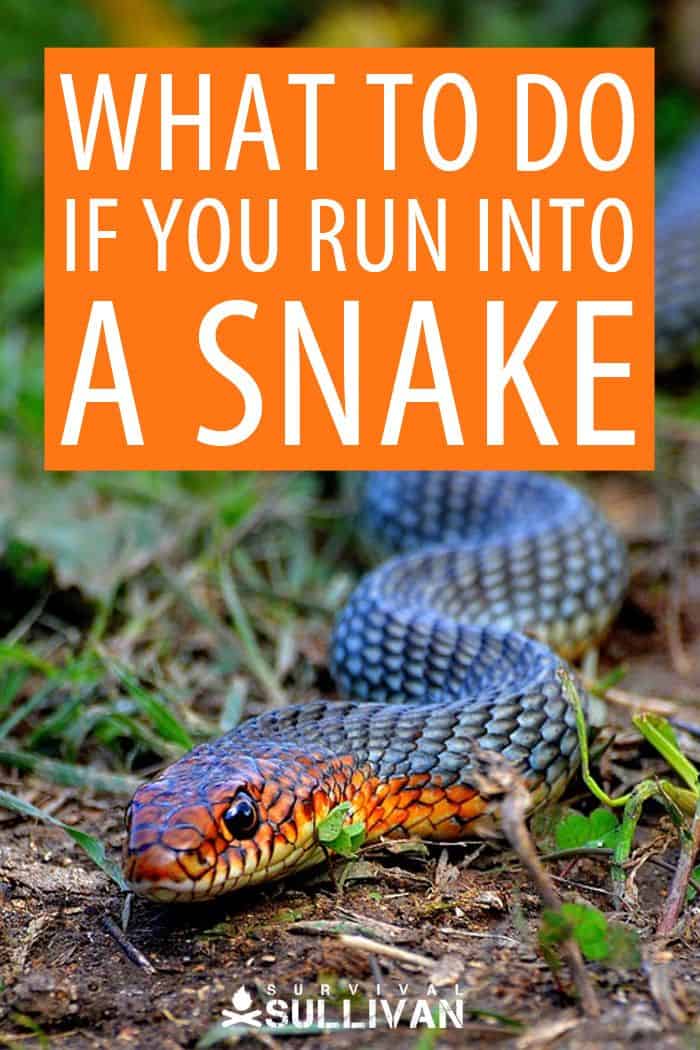

Traveler, photographer, writer. I’m eternally curious, in love with the natural world. How people can survive in harmony with nature has fueled my food safety and survival gardening practices.
At the age of 12, I found a newspaper advertisement for a 155-acre farm at a really good price and showed my parents one Sunday morning. They bought it and I happily started planting vegetables, peanuts, maize and keeping bees with the help of the local labor.
Once I married wherever we moved it was all about planting food, keeping chickens and ducks, permaculture and creating micro-climates. I learned how to build wooden cabins and outdoor furniture from pallets, and baked and cooked home-grown produce, developing recipes as I went along.

It gets to me when people say they carry guns with rat shot in them to kill ‘attacking snakes’. Just walk around them, and carry something that will protect you if a bear or couger attacks. Come on people.
Every article on snake bite says get to the ER right away. I have lived where the trip to the ER is not just down the street and may take hours. Everyone says don’t cut and suck out the venom. Based on this the question is what do you do when the ER is far away or after disasters when there is no medical help to begin with. Sure I want the ER and trained help but what do we do when that is not available. I don’t want a situation like I had with my dog when it had a broken leg with the bones through the skin and was told that they would make an appointment in just over 2 weeks for her. I set it myself and got lucky, you can’t tell it was broke but i can’t stay in Holiday Inns every night.